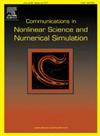Price predictability at ultra-high frequency: Entropy-based randomness test
IF 3.8
2区 数学
Q1 MATHEMATICS, APPLIED
Communications in Nonlinear Science and Numerical Simulation
Pub Date : 2024-11-22
DOI:10.1016/j.cnsns.2024.108469
引用次数: 0
Abstract
We use the statistical properties of Shannon entropy estimator and Kullback–Leibler divergence to study the predictability of ultra-high frequency financial data. We develop a statistical test for the predictability of a sequence based on empirical frequencies. We show that the degree of randomness grows with the increase of aggregation level in transaction time. We also find that predictable days are usually characterized by high trading activity, i.e., days with unusually high trading volumes and the number of price changes. We find a group of stocks for which predictability is caused by a frequent change of price direction. We study stylized facts that cause price predictability such as persistence of order signs, autocorrelation of returns, and volatility clustering. We perform multiple testing for sub-intervals of days to identify whether there is predictability at a specific time period during the day.
超高频率下的价格可预测性基于熵的随机性测试
我们利用香农熵估计器和 Kullback-Leibler 发散的统计特性来研究超高频金融数据的可预测性。我们开发了一种基于经验频率的序列可预测性统计检验方法。我们发现,随机性程度会随着交易时间聚合度的增加而增加。我们还发现,可预测日的特点通常是交易活跃度高,即交易量和价格变化次数异常高。我们发现有一类股票的可预测性是由价格方向的频繁变化造成的。我们研究了导致价格可预测性的风格化事实,如订单符号的持续性、回报的自相关性和波动性集群。我们对一天中的子区间进行多重测试,以确定一天中的特定时间段是否存在可预测性。
本文章由计算机程序翻译,如有差异,请以英文原文为准。
求助全文
约1分钟内获得全文
求助全文
来源期刊

Communications in Nonlinear Science and Numerical Simulation
MATHEMATICS, APPLIED-MATHEMATICS, INTERDISCIPLINARY APPLICATIONS
CiteScore
6.80
自引率
7.70%
发文量
378
审稿时长
78 days
期刊介绍:
The journal publishes original research findings on experimental observation, mathematical modeling, theoretical analysis and numerical simulation, for more accurate description, better prediction or novel application, of nonlinear phenomena in science and engineering. It offers a venue for researchers to make rapid exchange of ideas and techniques in nonlinear science and complexity.
The submission of manuscripts with cross-disciplinary approaches in nonlinear science and complexity is particularly encouraged.
Topics of interest:
Nonlinear differential or delay equations, Lie group analysis and asymptotic methods, Discontinuous systems, Fractals, Fractional calculus and dynamics, Nonlinear effects in quantum mechanics, Nonlinear stochastic processes, Experimental nonlinear science, Time-series and signal analysis, Computational methods and simulations in nonlinear science and engineering, Control of dynamical systems, Synchronization, Lyapunov analysis, High-dimensional chaos and turbulence, Chaos in Hamiltonian systems, Integrable systems and solitons, Collective behavior in many-body systems, Biological physics and networks, Nonlinear mechanical systems, Complex systems and complexity.
No length limitation for contributions is set, but only concisely written manuscripts are published. Brief papers are published on the basis of Rapid Communications. Discussions of previously published papers are welcome.
 求助内容:
求助内容: 应助结果提醒方式:
应助结果提醒方式:


